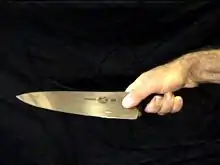Cookbook | Recipes | Ingredients | Cooking techniques
Cutting is one of the most basic kitchen preparation skills. By far the most common utensil for this is a chef's knife, although a paring knife and others are also used. With practice, cutting food can be safe, fun, and easy, and is a skill that is well worth developing for anyone who prepares food.
Maintenance
- Sharpening
- Knives should always be kept sharp – cuts occur more frequently with dull knives because they have a tendency to slip off the food being cut, rather than biting in. Use a honing steel to straighten the edge before each cutting session, and sharpen the blade by grinding a new edge when necessary, typically every few months or years, depending on use.
- Storage
- Knives should be stored separately from other utensils, either in a knife block, a knife tray, or with a knife guard.
- Never leave knives in a sink full of soapy water.
- Never try to catch a falling knife.
- Mechanical slicers
- Never try to clean the circular blade of a mechanical slicer while the machine is still assembled.
- Always ensure that mechanical slicers and other electrical cutting equipment are disconnected from the power supply before disassembling them for cleaning.
Use

Knife grip
Holding a knife:
When slicing food by hand, always grip the handle of the knife firmly – a loose grip can lead to accidents.
- The Grip: The correct grip gives one the maximum degree of control over the knife. It increases one's accuracy and speed, as well as preventing slipping which can cause accidents. The type of grip one uses depends to some extent on the task being performed, as well as the size of the knife. The grip most frequently used for general cutting and slicing is the one illustrated. Grasp the handle in the palm of the hand with the thumb on one side of the blade, the forefinger on the other side, and the middle, ring and small fingers wrapped around the handle. This is believed by many food-service professionals to give maximum control.
Food grip
The food item is held firmly with the other hand, the fingers curled under, so that the side of the blade is against the knuckles. The curling under of the hand holding the food is extremely important and a safety requirement that must never be disregarded even when the knife is nowhere near ones fingers so as to make it a habit that becomes automatic. Many accidents, and indeed the loss of digits, could have been avoided if this technique were always followed. Regrettably, even professionals sometimes disregard their own rules. Resist the temptation to do so.
Other
- When using a mandoline, use the food holder which is supplied with it. If it didn't have one when you bought it, it is quite likely being illegally sold in your jurisdiction which probably requires that they be sold with a holder included.
- When passing a knife to another, do so handle first.
See Also
External Links
- "Basic Knife Technique." Cook’s Illustrated, January/February 1996.
- "Basic Knife Techniques." Cooking Enthusiast, 2006.
- Marsha Lynch: Basic Knife Skills
- British Nutrition Foundation videos on basic peel, chop and grate techniques